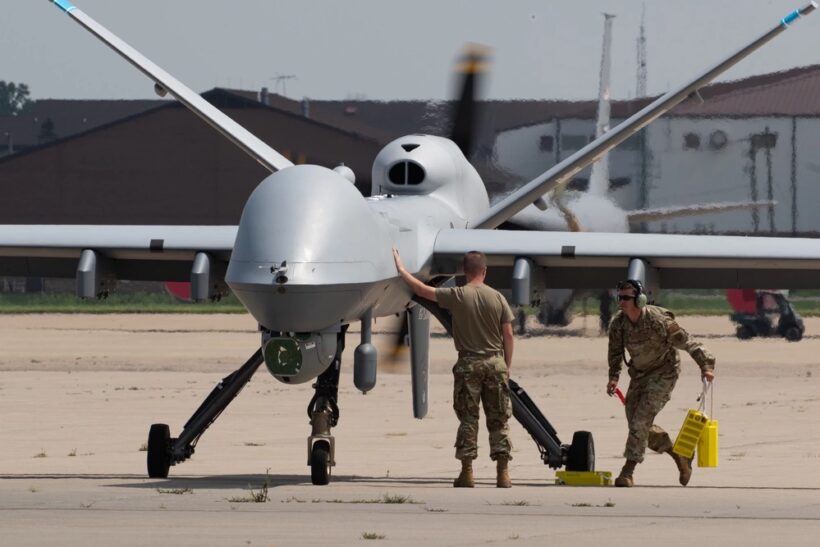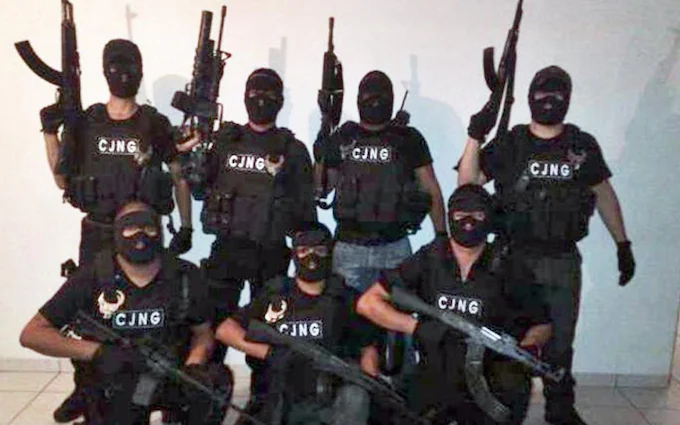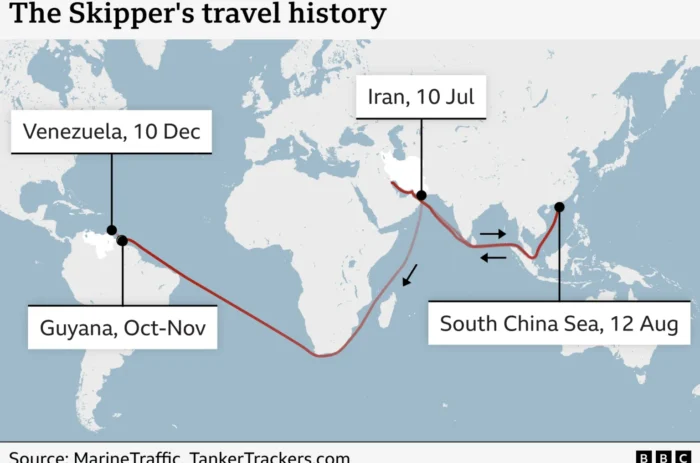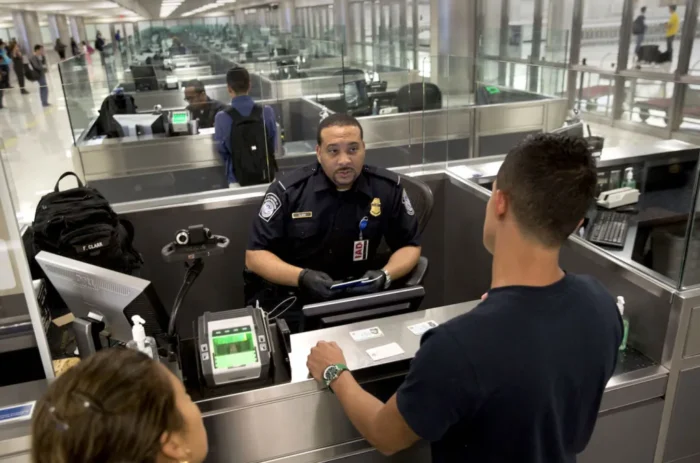
Master Sgt. Matthew Spears and Staff Sgt. Colin Coakley from the 174th Attack Wing Aircraft Maintenance Squadron from Hancock Field Air National Guard Base, Syracuse, NY place wheel chocks down to stabilize an MQ-9 Reaper on the flightline following its arrival to Niagara Falls Air Reserve Station, NY, Aug. 9, 2023. USAF Photo by Senior Airman Kylar Vermeulen.
print Print...
(by Mike Heuer, UPI) — The CIA is deploying unmanned drones over Mexico to search for fentanyl labs run by drug cartels after the Trump administration declared cartels are terrorist organizations.
The CIA has been using MQ-9 Reaper drones as part of the Trump administration’s use of national security tools at the southern border with Mexico amid a fentanyl crisis, CNN, the Daily Mail and DNYUZ reported.
The drones are unarmed but could be armed as needed to conduct precision strikes on fentanyl labs and cartel activities if needed, CNN reported.
Declaring drug cartels to be terrorist organizations could enable the U.S. military to carry out strikes against the cartels and drug labs in Mexico, but the drones so far are not authorized for lethal strikes while conducting counter-narcotics missions, CIA Director John Ratcliffe told agents.
Stopping the flow of deadly fentanyl into the United States has made Mexican drug cartels and others that produce and traffic fentanyl in the United States a priority for the CIA, an agency official told CNN.
The fentanyl labs can be placed in rural or urban areas and release chemicals that drones can detect with their sensors.
Drones piloted by artificial intelligence also can surveil particular areas for extended periods while collecting information on cartel activities, including who enters and exits drug labs, when precursor materials arrive to make fentanyl and when the final product leaves the respective labs.
The information makes it possible to intercept drug shipments into the United States and raid particular drug labs when possible.

The Jalisco New Generation Cartel is among the most powerful of the Mexican gangs that are heavily involved in the narcotics trade including fentanyl.
Mexican President Claudia Sheinbaum and other senior Mexican officials are aware of the drone flights and said they flights are occurring over international airspace over the border between Mexico and the United States and in U.S. airspace.
When CIA agents use the drones within Mexican airspace to collect intelligence on cartel activities, they share the drone footage with Mexican officials, the Daily Mail reported.
The CIA has completed more than two dozen drone flights near the border and has a team of 140 intelligence experts to analyze the surveillance footage.
Northern Command leader Gen. Gregory Guillot last week told members of the U.S. Senate the intelligence his team collects helps Mexican officials to “address cartel violence” by deploying more troops to the border.
Guillot said the drone surveillance operation has led to “rapid progress” in dealing with fentanyl trafficking in the United States.
U.S. officials have used drones to surveil cartel activities during the Biden administration, but the Mexican government often reacted slowly when given useful intelligence.
Mexican authorities eventually would use such intelligence to arrest cartel members, though.
Published at United Press International (UPI). Reprinted here for educational purposes only. May not be reproduced on other websites without permission.
From CNN: Shift in counter-terror assets
The CIA drone flights, combined with the expected cartel designations, underscore how the Trump administration is working to shift a broad range of counterterrorism authorities and resources to counter-cartel work along the US-Mexico border and inside Mexico itself.
Planning for that shift started even before Trump took office. A 30-page Trump transition planning document titled “2025 Agency Action Plan,” reviewed by CNN, outlined the Trump administration’s early priorities for the intelligence community to “reprogram [counterterrorism] resources.”
“Treat counter-drug cartel work as a form of counter-terrorism and use those authorities and unique resources appropriately, including by moving resources from other regions if necessary,” the document directed.
In 2019 during his first term, Trump said that the US was ready to “wage war” on the groups, tweeting that “the cartels have become so large and powerful that you sometimes need an army to defeat an army.”
And while signing an executive order on January 20 that called for some to be designated foreign terrorist organizations, Trump was asked by reporters whether he would send special operations forces to Mexico. (Read President Trump’s Executive Order designating the cartels and other gangs as terrorist organizations at whitehouse.gov)
“Could happen,” Trump said. “Stranger things have happened.”
Trump’s national security adviser Mike Waltz has also previously advocated for offensive action against Mexican drug cartels. As a member of Congress, in 2023, he co-introduced legislation creating an authorization for the use of military force against them.
In response to the January 20 executive order, the State Department drafted a list of cartels that it believes should be designated foreign terrorist organizations, according to an official familiar with the matter. The formal designations have not been made yet, but the State Department sent a list of drug cartels to Congress last week that it is planning to designate, two sources familiar with the matter told CNN.
The list includes transnational gangs MS-13 and Tren de Aragua, as well as several cartels active in Mexico including the Sinaloa, Jalisco, Zetas and Gulf cartels, Cartel Unidos and La Nueva Familia Michoacana (LNFM).
Extremist Islamist groups make up the vast majority of currently listed foreign terrorist organizations. Those groups differ from the cartels in key ways.
Former officials and analysts say that, though they share some operational similarities, the cartels are essentially commercial organizations, not ideological ones; they are not interested in governing populations or seizing territory; and they in some cases are deeply entwined with parts of the Mexican government, which the US military actively partners with and supports on counter-narcotics initiatives.
(from a CNN report on Feb. 18 by Natasha Bertrand, Katie Bo Lillis and Zachary Cohen, with Priscilla Alvarez.)
Questions
1. The first paragraph of a news article should answer the questions who, what, where and when. (In this article, 1st and 2nd paragraphs). List the who, what, where and when of this article. (NOTE: The remainder of a news article provides details on the why and/or how.)
2. In what situation would the US potentially arm these unarmed Reaper drones?
3. How do the drones detect the fentanyl labs in Mexico?
4. a) What information do the drones collect when surveilling for extended periods of time?
b) How does the CIA use this information?
5. a) How many drone flights has the CIA completed in this first month of the Trump administration?
b) How many intelligence agents are working to analyze the surveillance footage collected by the drones?
Resources
Read President Trump’s Executive Order designating the cartels and other gangs as terrorist organizations at whitehouse.gov.
February 18, 2025:
Daily “Answers” emails are provided for Daily News Articles, Tuesday’s World Events and Friday’s News Quiz.



